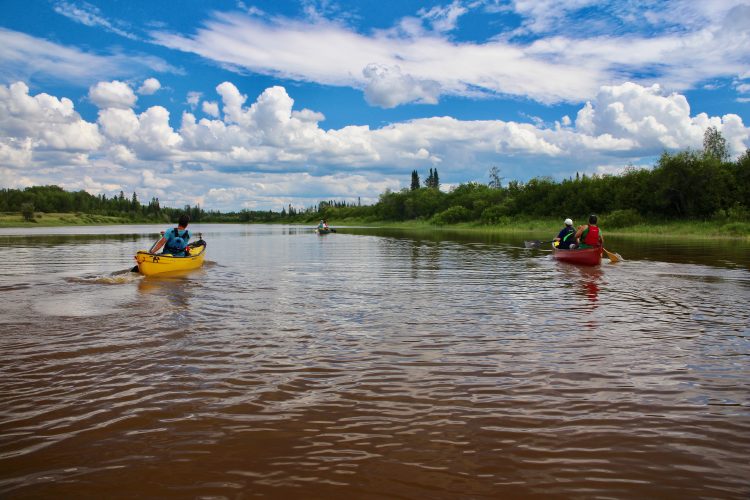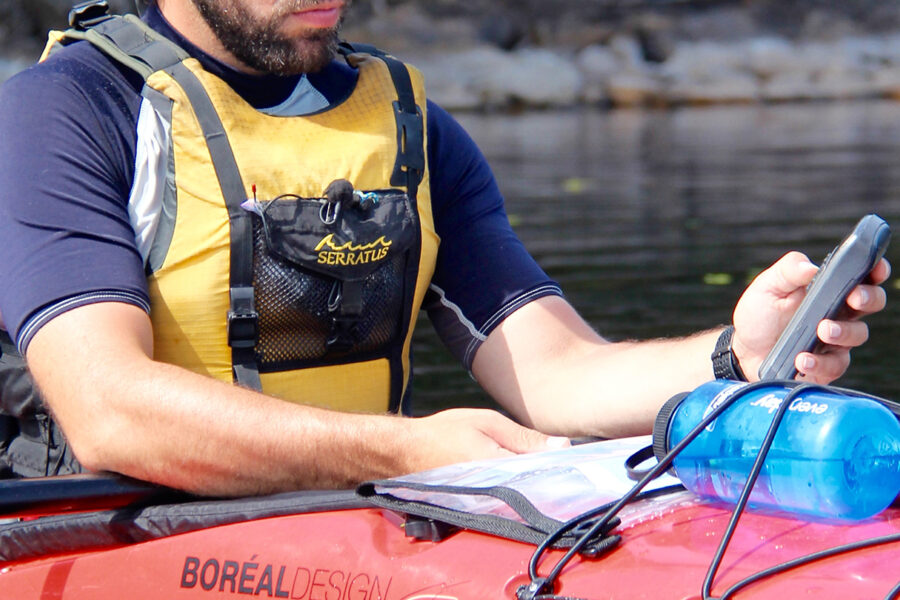Home > Canoe > Harricana Abitibi8innik Paddling Trail
Harricana Abitibi8innik Paddling Trail
Harricana Abitibi8innik Paddling Trail
Amos, Amos Région
- electrocardiogram Easy
- mountain 40.9 Km (Linear)
- calendar seasonal
Sections
Amos à l’embouchure du lac Obalski
- electrocardiogram Moderate
- mountain 24,8 km (Linear)
- elevation Elevation
Access : Par la rampe de mise-à-l'eau de la marina d'Amos
Interest : Parcours des Abitbi8innis, campements autochtones, relief relativement plat, milieu relativement sauvage, rives argileuses, forte concentration de résidences sur les rives en début de parcours.
Danger : 3 rapides de classes RI.
Lac Obalski
- electrocardiogram Moderate
- mountain 7,6 km (Linear)
- elevation Elevation
Interest : Milieu sauvage, relief relativement plat, rives rocheuses et sablonneuses.
Danger : Tumultueux par grand vent.
Retour du lac Obalski au pont couvert
- electrocardiogram Easy
- mountain 8.5 km (Linear)
- elevation Elevation
Access : Par le lac Obalski
Points of service and interest
Category Name
-
Launching ramp Rampe de mise à l’eau du Club nautique d’Amos (chemin de la Marina, Amos) 48°33'31.39”N
78°6'41.461”O -
Cultural Visit Abitibi8inni55, rue Migwan, PikoganT 819 732-3350 48°35'51.5"N
78°07'11.8"O -
Point of interest Abitibiwinni, l'expérience algonquine 55, rue Wigwan, PikoganT 819 732-3350 48°35'51.7"N
78°07'11.8"W -
Wild camping Camp algonquin 48°40'52.473”N
77°59'45.241”O -
Carrying Portage du rapide de Pikogan 48°36'4.482”N
78°6'35.077”O -
Rapids Rapide de Pikogan 48°36'4.34”N
78°6'31.924”O -
Carrying Portage du rapide Ka Kinwatciwanak 48°37'37.91”N
78°1'24.813”O -
Wild camping Camping sauvage de la rivière Harricana 48°12'50.189N
77°58'2.425”O -
Launching ramp Rampe de mise à l’eau aux abords du pont couvert du chemin Rivest 48°38'38.206”N
78°0'12.779”O -
Rapids Rapide au centre de la ville d’Amos 48°34'44.017”N
78°7'15.455”O -
Rapids Rapide Ka Kinwatciwanak 48°37'40.025”N
78°1'23.86”O -
Wild camping Camping sauvage de l'île du lac Obalski 48°44'16.255”N
77°57'32.111”O -
Sandy beach / Swimming Plage 48°44'40.776”N
77°58'2.816”O -
Launching ramp Rampe de mise à l'eau du lac Obalsky 48°46'41.7"N
77°57'43.9"O -
Launching ramp Rampe de mise-à-l'eau de Saint-Dominique-du-Rosaire 48°47'34.3"N
78°00'51.0"O
Accessibility
Directions to the starting point
To Amos, go to the end of the way to the Marina.
Public outdoor parking and launching ramp.
Position : 78°6'41,461"O 48°33'31,39"N
Directions to reach the point of arrival:
From Amos, take the 395 North road towards Saint-Maurice-de-Dalquier. Turn left on the Rivest road to the covered bridge.
Public outdoor parking and launching ramp.
Position : 78°0'12,779"O 48°38'38,206"N
Specifications
Topographic Maps
Topographic maps at a scale of 1/50,000 exist for the entire river route and we recommend that you use them in conjunction with this guide map.
32 D/9 Harricana River
32 C/12 Harricana River, Obalski Lake
Total slope: 3 metres
Danger, fast and carry
Lake Obalski is turbulent in strong winds.
The three rapids are class Rl.
It is possible to carry the first rapid in urban areas on the right bank but no portage is arranged.
Well-maintained portage trails for rapids 2 and 3.
Campsite
Sufficient camping sites. They are spread out along the route and vary in quality.
Natural Environment
Geography
James Bay watershed
The Harricana River flows northwards, originates in Blouin, De Montigny, Lemoine and Mourier lakes, and empties into James Bay some 553 km further north.
The Harricana River is the second longest waterway in Canada (170 km of waterway). It originates in the lakes Blouin, De Montigny, Lemoine and Mourier near Val-d'Or and flows into James Bay some 553 kilometres to the north.
Fauna
The course is known for its very diverse wildlife which includes, among others, black duck, kingfisher, great heron, great woodpecker, porcupine, red squirrel, beaver, muskrat, hare, weasel, marten, mink, striped skunk, otter, orignal, black bear, grey wolf, coyote, red fox, lynx.
Flora
The water bodies are located in the boreal forest in the area of white birch fir, which includes, among others, cedar, white and black spruce, balsam fir, aspen and birch.
History
An interesting flow and relatively calm terrain, relative to the other rivers of James Bay, have made the Harricana River a busy waterway. The first users were the Algonquins. As a tributary of James Bay, and thus of Hudson Bay, the Harricana River and its basin were owned by the Hudson’s Bay Company until they were purchased by Canada in 1869. The territory was officially annexed to the province of Quebec in 1898 and settlement efforts began. In 1906, Henry O'Sullivan explored the banks of the Harricana and in 1908, the first camps were established on the banks of the river at the height of the rapids. These are supply camps for the construction of a transcontinental railway. Some years later, in 1910, the first settlers arrived and founded the town of Amos in 1912 at the point where the railway crosses the river.
Toponymy
The original name of the Harricana River is "Nanikana". But the missionaries of the time learned the Algonquin language from sound and distorted this word to make it "Harricana". The Algonquin expression Nanikana takes on its full meaning when it is explained that it means " The main way". Some sources claim that the name is of Algonquin origin and means Biscuit River. The term biscuits refers to the many flat pebbles found on the banks of the river.
Comments social0
Tools ready to go
- pdf Planification
- pdf Pmu Harricana Nord
- pdf Ps Harricana Nord
- pdf Autoevaluation Kayak
- pdf Equipement Kayak
- pdf Trousse Kayak
- pdf Autoevaluation Canot
- pdf Equipement Canot
- pdf Trousse Canot
Info & advice
- Animation et interprétation
- Camping
- Care
- Carte et orientation
- Caution
- Classification
- Emergency
- Equipment
- Jamais sans mon chien
- Nutrition
-
Prevention
- 10 articles de première nécessité
- Bien s'hydrater
- Comment lire la météo dans les nuages? Faire la pluie et le beau temps !
- Connaître son groupe et son plan d’eau
- Éviter les mauvaises rencontres en milieu sauvage
- Feu de camp sécuritaire : trois étapes à respecter
- Insectifuges
- Les moustiques
- Lunettes de soleil
- MALADIE DE LYME : PRÉVENIR LES PIQÛRES DE TIQUE EN RANDONNÉE
- Perdu en forêt : quoi faire?
- Règles de sécurité en canot et en kayak
- Se protéger contre le soleil
- Signalisation nautique internationale
- Vaporisateur Chasse-ours
- Progression
- Réglementation
- Training
Caution
This sheet has been prepared from information provided by outdoor enthusiasts deemed sufficiently reliable and experienced. Errors or omissions are always possible and Tourisme Abitibi-Témiscamingue cannot accept responsibility for any problem or accident that may arise from this sheet or be attributed to its use. If you notice any errors or omissions during your expedition, we would be very grateful if you would let us know by email pleinair@atrat.org in order to keep our information up to date.
Fichier GPX pour GPS
Ce fichier texte est en format GPX. Il contient les données de traces et de points de navigation (waypoints). Il peut être visualisé via un éditeur de texte. Téléchargez gratuitement le gratuiciel GPS Babel pour importer le fichier contenant les traces et les points de navigation dans votre GPS.
Étapes
- Télécharger le fichier GPX
- Ouvrir le logiciel GPS Babel
- Dans la section INPUT, sélectionner « Fichier ». Dans la rubrique Format, à l’aide de la liste déroulante, « GPX XML ». Cliquer sur le bouton File Name(s) pour accéder au fichier GPX téléchargé dans l’ordinateur.
- Dans la section Translation Options, sélectionner « Waypoints » et « Traces ».
- Brancher le GPS à l’ordinateur à l’aide d’un câble USB.
- Dans la section Sortie, sélectionnez « Périphérique ». Choisir le format correspondant à la marque du GPS. Dans la rubrique Nom de périphérique, sélectionner « usb : ».
- Cliquer sur le bouton Appliquer
Harricana Abitibi8innik Paddling Trail
Location : |
Harricana Abitibi8innik Paddling Trail





